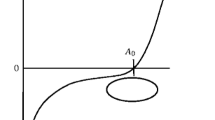Summary
The coronary arteries are a system of elastic tubes with one end open to the aorta and with a high resistance at the other end.
The basic pattern of coronary input flow is determined 1. by the primary inflow wave due to the aortic pressure pulsation and 2. by a secondary wave which is generated by the periodic obstruction of outflow at the peripheral resistance due to the contraction of the heart.
By means of the simplified model of a homogeneous elastic tube, details and oscillations of the coronary flow pattern could be explained as due to reflection and superposition of these primary and secondary waves. Flowpatterns constructed by use of this model were compared with flow pulses recorded in anesthetized dogs in the left circumflex coronary artery with an electromagnetic flowmeter.
A characteristic feature of the apparent input impedance of a coronary artery has been found experimentally and could be explained by the fact, that the myocardial contraction serves as an additional energy source within the coronary system.
The possible usefulness and physiological importance of the application of analytical methods to the hemodynamics of the coronary arteries is discussed.
Similar content being viewed by others
References
Attinger, E. O.: Pulsatile blood flow. New York-Toronto-London 1964.
Berne, R. M.: Regulation of coronary blood flow. Physiol. Rev.44, 1–29 (1964).
Gregg, D. E.: Coronary circulation in health and disease. Philadelphia 1950.
Hardung, V.: Zur mathematischen Behandlung der Dämpfung und Reflexion der Pulswellen. Arch. Kreisl.-Forsch.18, 167–172 (1952).
Kenner, Th.: Experimentelle Untersuchungen zur Analyse der Umformung von Druckpulsen im arteriellen System an Kaninchen. Z. Biol.113, 125–144 (1962).
—, u.R. Ronniger: Untersuchung über die Entstehung der normalen Pulsformen. Arch. Kreisl.-Forsch.32, 141–173, (1960).
—, u.E. Wetterer: Experimentelle Untersuchungen über die Pulsformen und Eigenschwingungen zweiteiliger Schlauchmodelle. Pflügers Arch. ges. Physiol.275, 594–613 (1962).
Khouri, E. M., andD. E. Gregg: Miniature electromagnetic flowmeter applicable to coronary arteries. J. appl. Physiol.18, 224–227 (1963).
Kolin, A., andR. T. Kado: Miniaturization of the electromagnetic blood flow-meter and its use for the recording of circulatory responses of conscious animals to sensory stimuli. Proc. nat. Acad. sci. (Wash.)45, 1312–1321 (1959).
Laszt, L., u.A. Müller: Über Druck- und Geschwindigkeitsverhältnisse im Coronarkreislauf des Hundes. Helv. physiol. pharmacol. Acta15, 38–54 (1957).
Wettterer, E., u.Th. Kenner: Grundlagen der Dynamik des Arterienpulses. Berlin-Heidelberg-New York: Springer 1968.
Author information
Authors and Affiliations
Additional information
Dedicated to Prof. Dr.E. Wetterer on occasion of his 60th birthday.
Supported by NIH Grant HE-09694 and the Graduate Incentive Fund from the State of Virginia.
Rights and permissions
About this article
Cite this article
Kenner, T. The dynamics of pulsatile flow in the coronary arteries. Pflugers Arch. 310, 22–34 (1969). https://doi.org/10.1007/BF00586872
Received:
Issue Date:
DOI: https://doi.org/10.1007/BF00586872




